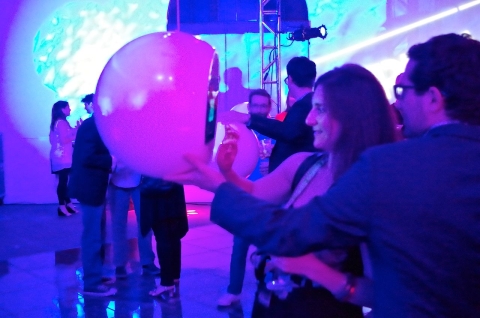Do You Know the Difference Between NFC and Bluetooth® Beacons?

There has been a lot of talk in the events industry lately about NFC (Near Field Communication) and Bluetooth® beacons. There are those who are in the NFC camp and others who are in the beacon camp.
The fact is, both have a role in trade shows, depending on what you are trying to achieve. Let’s take a closer look at what each of these technologies does.
NFC is a set of standards for “devices” to establish radio communication with each other by either touching them together or bringing them into close proximity. That is the “near” part of near field communication. Usually close proximity means no more than a few inches at best.
Bluetooth beacons are transmitters that use Bluetooth Low Energy 4.0 to broadcast signals that can be heard by compatible or smart devices.
A typical example would be a signal transmitted from a beacon to a smartphone. When the smartphone is in a beacon’s proximity (from inches to 100 or so feet), the beacon will automatically recognize it and will be able to interact with that device.
Note that NFC is an active technology where Bluetooth beacons are more passive. However, NFC does not require the attendee at the show to download any application whereas beacons do.
Steve Statler, Qualcomm Retail Solutions Inc., states in a blog post (Spotlight: Bluetooth Beacons vs. NFC, the Fight That Wasn’t What It Seemed) that these technologies are hammers and saws in a chest of tools that developers can use, based on their different strengths and capabilities, to create the optimal user experience.
Statler went on to say, “this is about use case, not about either/or.” What are some potential use cases in trade shows?
An attendee badge could be created to be an NFC device. NFC “tags” could be embedded into digital displays or posters. An attendee could touch their badge to a sponsor display to retrieve a “gift” or use their badge to activate a download of a brochure or white paper in an exhibitor’s booth.
At Event Farm’s 2.0: New Media Party in Washington, D.C., attendees were able to use their credentials connected to Event Farm’s HOVER™ technology to send photo booth pictures via their social networks, download prizes from sponsors and even get automatic downloads of songs that were playing, right from the dance floor.
Would 2.0: New Media Party attendees intuitively understand how to use all this new technology? Ryan Costello, CEO of Event Farm, explained, “It’s meant to be exploratory and fun. This party is new media, delivering content in new ways. You don’t present this technology in a corner, in a kiosk.”
Alternatively, beacons are a much more passive technology, as far as the attendee is concerned. Exhibitors can use beacons to push timely and relevant information to an attendee’s smartphone as they were passing by.
Those messages could even be filtered based on the attendee’s interests identified within the app.
Statler said, “there are a lot more options (with Bluetooth) to make the experience fun. You could gamify it within the mobile event app.” Show organizers are always looking for ways to draw traffic to more remote areas of the exhibit hall and beacons could be the answer to this problem.
The San Diego Convention Center is working with Total Communicator Solutions Inc. to provide beacon technology to show organizers, exhibitors and visitors to San Diego.
“It is our goal to utilize new and relevant technology for our convention show managers so their attendees have the best possible experience while attending their convention in San Diego,” said Carol Wallace, president and CEO of the San Diego Convention Center.
With any new technology, you have to take into account there will be a learning curve for the show organizers, exhibitors and sponsors, as well as the attendee.
If you implement either of these technologies, you will have to be prepared to communicate clearly how to use them and what the benefit is.
You’ll also want to have people on hand to assist attendees in how to use the technology. Whether it is helping them bump or hover their badges properly or how to download the appropriate app on their smartphone, they will need assistance at first.
Both NFC and Bluetooth beacon technology have amazing potential for show organizers. It will be interesting to see how event and show organizers incorporate it into their programs and how attendees react.


Add new comment